Brand archetype
Brand Archetype
A brand archetype is a universally recognized concept that can fundamentally shape your brand’s behavior. It’s a tool to stand out and to connect with your audience on a profound level. This is an invaluable asset for crafting your brand’s positioning and maximizing the impact of your marketing budget.
On this page, we not only explain what brand archetypes are, where they originate from, and how to use them, but we also delve into each individual brand archetype. Want to explore further? Read one of our articles about a specific brand archetype. There, we detail how you can harness this archetype for your brand and positioning.
What is a Brand Archetype?

The hero is one of the most recognizable brand archetypes, think of Nike
Brand archetypes are universally understood. Characters like the hero and the mother are fundamental figures whose meanings are universally known. This holds true across the globe! Brands that align with a single brand archetype tap into this recognizability, enhancing their brand value.
A brand archetype provides clarity about the brand DNA and offers guidelines for an effective, consistent brand strategy. The audience recognizes what the brand stands for, its purpose, and the values it embodies. This is crucial in an era where more brands are vying for attention and it’s increasingly challenging to stand out based on basic features and benefits.
A brand archetype helps your brand carve out a unique position in your market. Research by Young & Rubicam (now VMLY&R) based on 13,000 brands in 33 countries1 shows that brands strongly aligned with a single brand archetype perform better (97% more growth) than those that do not.1 The Hero and the Outlaw, Mark/Pearson, 2001 McGraw-Hill, page 30
Origin of Brand Archetypes
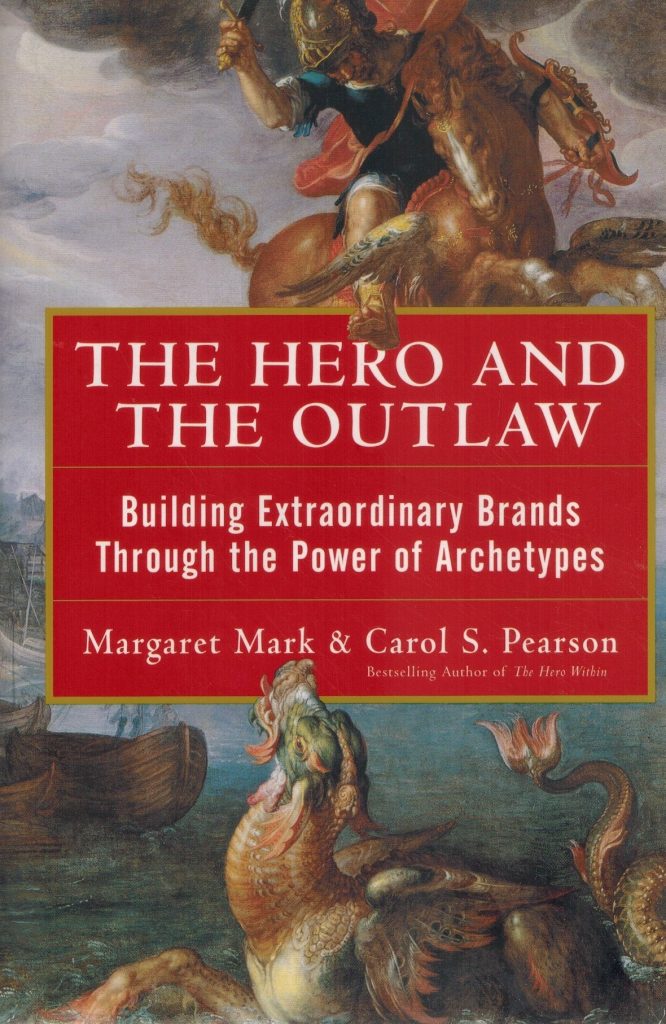
The cover of ‘The Hero and the Outlaw’ which first discussed the twelve brand archetypes
Psychologist Carl Jung coined the term archetype in 1919, building upon the foundations laid by classical thinkers such as Plato, Cicero, and Augustine. Jung used archetypes to interpret certain experiences, ideas, and observations. He describes archetypes in his book, Psychology and Religion, as: “Forms or images of a collective nature that appear practically worldwide as components of myths and simultaneously as individual products of subconscious origin.” Thus, archetypes represent behavior patterns that we all instinctively understand.For marketers and communication specialists, this way of thinking had long held great allure, but it wasn’t until 2001 that Mark and Pearson encapsulated it in their book ‘The Hero and the Outlaw’. The 12 brand archetypes were born. A decade later, Hartwell and Joshua Chen expanded this into 60 brand archetypes spread across the 12 families in the workbook ‘Archetypes in Branding’. There is also a Dutch book that delves into this topic; The Five Steps to a Meaningful Brand.Finally, there’s the book ‘The Hero with a Thousand Faces‘ by Joseph Campbell (1949); he explains that the hero’s journey is central to mythology and, for instance, was a major inspiration for George Lucas when writing Star Wars.
The above books form the foundation of our own interpretation of brand archetypes, and we weave insights from all these works into the individual articles on brand archetypes.
Positioning and Brand Archetype
Brand archetypes and the positioning model are crucial levers for brands aiming to stand out. The brand archetype model—more on that later—helps clarify how competitors are positioned, and choosing a brand archetype is a key building block for a brand’s positioning. A brand selects an archetype that aligns with its culture and identity, allowing it to position itself distinctively. The brand archetype tells the story of how your brand behaves and connects with its audience.
Of course, there’s much more involved in positioning. Every year, Merkelijkheid assists a diverse range of brands in sharpening or renewing their positioning. You can find all our publications on this topic in our knowledge base.
Brand Archetypes Foster Connection

Being connected with your audience is the greatest asset for today’s brands
Why are brand archetypes such a powerful lever? Because we instinctively understand each archetype, a brand needs to explain much less. For instance, we don’t question why Nike sponsors top athletes; we actually expect it because it aligns with the hero archetype. And what other behaviors are associated with the hero? Chances are you won’t have to think long to answer that.
Our instinctive understanding of brands with a clear archetype makes us feel connected to them more quickly. And connection is the most valuable asset for brands. When a target audience feels connected to a brand, it not only leads to preference but also results in higher margins, advocacy, and loyalty.
Brand Archetypes Foster Differentiation
A brand archetype gives your brand personality, evoking a particular feeling in people. We recognize personality instantly. This allows your brand to stand out based on personality rather than features or benefits. Red Bull and Coca-Cola might be indistinguishable based on features and benefits, but you’d never confuse the two.

Even without the logo, you can probably guess the brand, right?
Brand Archetype and Purpose
Not only do customers want to connect with a greater purpose, but people also prefer to work for a company with a purpose.
Globally operating companies have been talking about a ‘war for talent’ for years, the increasingly competitive landscape for recruiting and retaining employees. This is becoming more evident in the Netherlands too, for example, in the tech industry, where there has been a chronic shortage of electricians for years.The right brand archetype is the fastest route to the mind of a potential candidate. When they understand your company effortlessly, it’s much easier for them to decide if they want to work for you. We increasingly encounter examples of companies that, due to their clear purpose, sometimes literally have a waiting list and consistently pay less for talent than is common in the market.
Who is the brand archetype, the customer or the brand?
Nowadays, everything revolves around the customer. While there are still brands that place themselves at the center, the majority of major brands focus on the customer in their universe.
Mercedes-Benz (Ruler) once declared: ‘The best or nothing,’ but now aligns much more with the desires of its customers. Nike (Hero) doesn’t portray itself as the hero; ‘Just do it’ motivates you to become the hero and run that marathon.
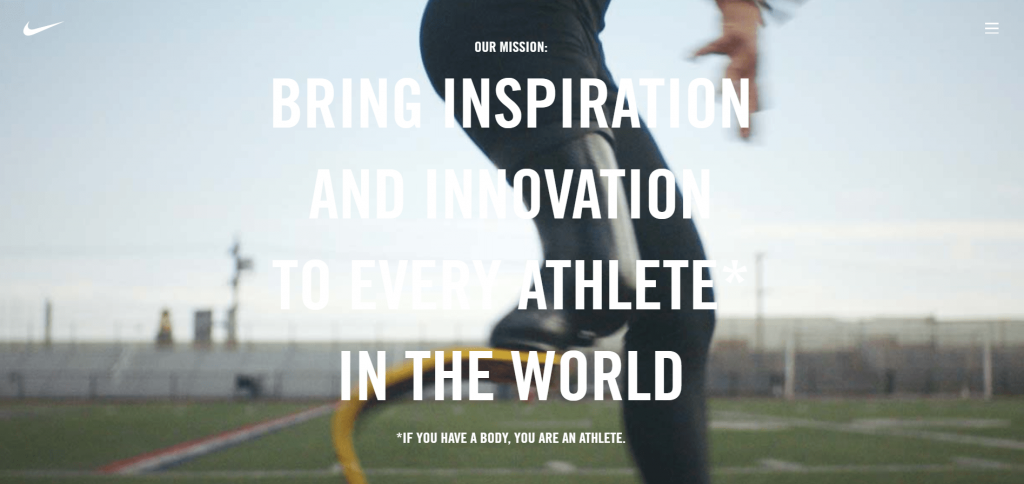
Nike’s mission statement
Your brand’s archetype determines which needs your brand facilitates for the customer. Take Patagonia (Explorer), for instance, a brand that provides you with the clothing and accessories to explore the world. Or Dove (Caregiver), which creates personal care products ensuring every woman feels beautiful. None of these brands are about themselves; everything revolves around their customers.
Brand Archetype Model
The twelve brand archetypes can be categorized along different axes. We use the axes Ego – Social and Freedom – Order to classify the brand archetypes. Mark and Pearson themselves use Stability – Mastery and Belonging – Independence. We prefer the former for its easier applicability in a business environment, as it seems more logical.
The world of car brands offers an engaging introduction to brand archetypes. Each brand archetype fits multiple brands, and for each brand, it doesn’t take much effort to understand why we categorize it this way.
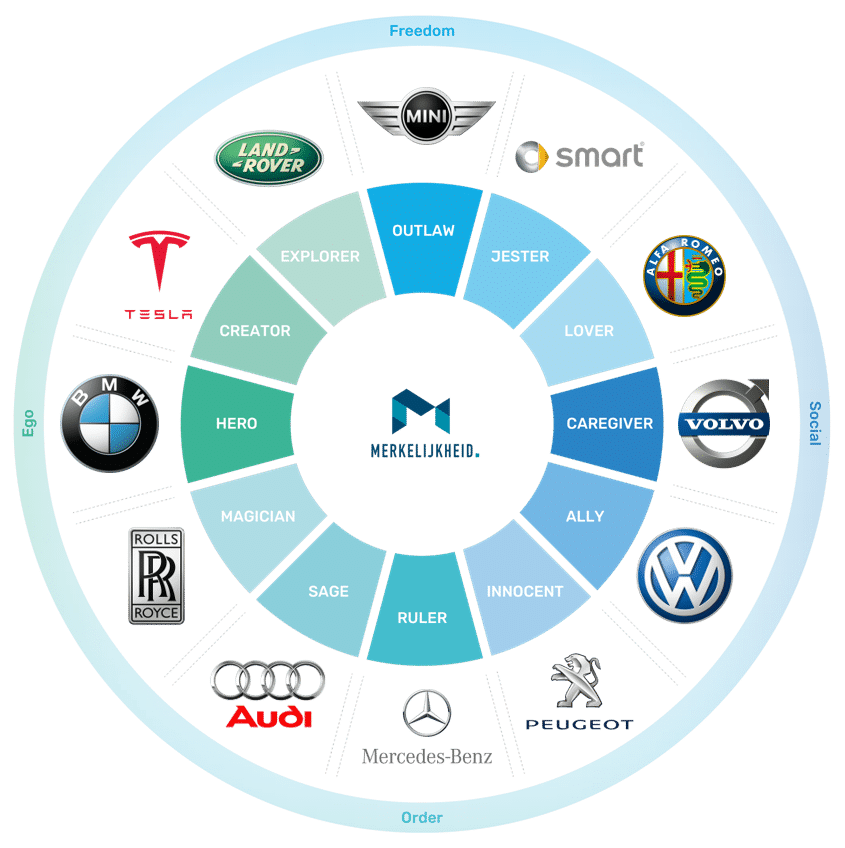
Using the Brand Archetype Model
If you wish to use this model to map out your market, answer the following questions for each competitor:
- Is this brand focused on Ego or Social? By this, we mean: does it primarily revolve around the customer themselves or the broader world around them?
- Does this brand value Order or is Freedom more important?
Next, determine where the brand is located in the quadrant. It can be practical to first categorize all competitors by quadrant and then, based on their differences, identify the specific brand archetype. And how do you position your own brand?
Brand Archetype and Culture or Identity
Can you simply choose any brand archetype? No. Which brand archetype fits your brand largely depends on the culture or identity of your organization. Is your company primarily internally oriented and do you value order? Then it’s unlikely that the Outlaw will suit you. However, the Ruler, Magician, or Ally might be a perfect fit.

A customer seeing two faces becomes confused
The main reason for this is customer perception. A company that presents a different face in its marketing than when you make contact is rarely successful. It creates a feeling that people are being misled. So, ensure that the brand archetype aligns with the identity or culture of the organization.Depending on the type of organization, we have various methods in practice to determine which brand archetype best suits your organization:
- Desk research
- Interviews
- Cultural research
Desk research involves studying available resources (both internal and external) and drawing conclusions which we then validate. Interviews mean we speak with a variety of people within the organization to uncover its identity. Cultural research is an approach we often use in workshops. Through engaging case studies, we discuss how an organization responds to certain situations. This is processed into a model based on Hofstede’s work and serves as the foundation for a lively discussion.
This results in a number of clear conclusions that can be used to guide or validate the choice of a specific brand archetype. This way, you can be sure you’re making the right choice.
12 Brand Archetypes of Jung
In our FAQ, we answer the question ‘What are Jung’s 12 archetypes?’. But we also delve deeply into each individual brand archetype:
- Hero Brand Archetype
- Caregiver Brand Archetype
- Explorer Brand Archetype
- Outlaw Brand Archetype
- Sage Brand Archetype
- Magician Brand Archetype
- Innocent Brand Archetype
- Creator Brand Archetype
- Jester Brand Archetype
- Ruler Brand Archetype
- Lover Brand Archetype
- Ally Brand Archetype
Hero Brand Archetype

Hero Brand Archetype: BMW
The Hero evokes clear images for all of us. This brand archetype is characterized by a strong sense of duty, a drive to prove oneself, and mastery. The Hero rises to the challenge, taking action and making a difference with their expertise. While this image is typical of the Hero brand archetype, it doesn’t always require showing physical strength. Hero brands empower their customers to push boundaries, grow, and become heroes themselves, fulfilling their (social) duties or harnessing personal strength, courage, and competencies to make an impact.
The Hero’s motivation is unparalleled, inspiring customers. Successful Hero brands cultivate a loyal, dedicated following, provided they avoid pitfalls: arrogance and the search for a (non-existent) enemy can alienate the Hero from their audience.
Famous examples of the Hero brand archetype include Nike and BMW. Curious about which business service provider or industrial organization we also see as a Hero? Read our full article on the Hero brand archetype. There, we’ll also delve into the motivations, benefits, pitfalls, and marketing of the Hero.
Brand Archetype: Caregiver
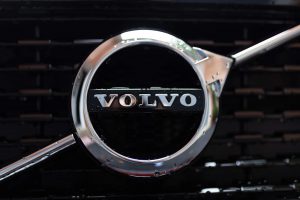
Brand Archetype: Caregiver – Volvo takes care of you
The Caregiver is a reliable and nurturing brand archetype, reminiscent of the classic image of a mother or teacher. Seeking a safe, orderly world where everyone looks out for each other, the Caregiver selflessly sacrifices, prioritizing the well-being of others. The Caregiver’s greatest concern is the instability or problems of others, and thus, they offer help to those in need, both solicited and unsolicited.Caregiver brands prioritize the customer’s needs and genuinely engage with them. Thanks to their positive impact on customers’ lives, innovations from successful Caregiver brands are more quickly embraced. However, the danger for Caregiver brands arises when their self-interest is completely overshadowed by the customer’s needs. After all, how can you safeguard everyone if your own goals, desires, and boundaries are unclear?
Volvo and the Red Cross are well-known examples of Caregiver brands. In our full article on the Caregiver brand archetype, we elaborate on these examples and introduce two new ones: a business service provider and an industrial company. We also delve deeper into the motivation, benefits, and marketing of the Caregiver brand archetype.
Brand Archetype Explorer

Land Rover Explorer shares its name with the brand archetype
Freedom is at the heart of the Explorer brand archetype. The freedom to venture out, discover your individuality, and truly be yourself. This brand archetype yearns for freedom and self-development. Combine both, and according to the Explorer, you achieve the ideal world.
For these adventurers, the journey holds more significance than the destination. A successful Explorer brand forms a deep connection with its audience and focuses on building a long-term relationship. While this brand archetype and its audience love to roam freely, Explorer customers still seek stability and a clear direction.
In our comprehensive article on the Explorer brand archetype, we explore more about the characteristics, benefits, and marketing of this brand archetype. Alongside examples like Land Rover and GoPro, we also provide a business and an industrial example.
Brand Archetype Outlaw

The Outlaw car brand: Mini.
Another name for the Outlaw is the Rebel. This brand archetype feels out of place and does not identify with the society it inhabits, thus challenging the status quo. Driven by a sense of freedom, independence, justice, or even revenge, the Outlaw creates a world that fits them. The Outlaw is not afraid to strike a nerve; provoking and shocking are indeed part of the process.
As a brand, the Outlaw breaks rules both within and outside its industry in the pursuit of change, with and for its audience. Outlaws are leaders, bold, and unafraid to take risks. The rebellious nature is also a pitfall, as rebelling for the sake of rebellion is not credible and won’t be accepted by potential customers.
Examples of Outlaw brands include Harley Davidson and Virgin. Curious about our examples from the industry or business services? Read our full article on the Outlaw brand archetype, where we delve deeper into the motivations, benefits, pitfalls, and marketing of the Outlaw brand archetype.
Brand Archetype: Sage

Brand archetype Sage: advancement through technology
The Sage is aptly named the Wise One, with knowledge and truth as the highest virtues for this brand archetype. The Sage aims to create a better world and believes that everyone can make good decisions if they have the knowledge. Like the Sage, their customers want to understand the world better and become smarter. They do not want to follow blindly but prefer to make informed choices, ideally based on factual information.
The customers of a Sage feel like experts because of their product or service, making the Sage brand archetype well-suited for high-quality or complex products and services. The greatest pitfall for a Sage is their attitude towards customers and their tone of voice. Sage customers want to be reassured that they are acting wisely and sensibly. A condescending or patronizing tone can spell the end of their loyalty.In our comprehensive article on the Sage brand archetype, we explain why Audi is a typical Sage and provide an example from the industry and business services. Naturally, we also delve deeper into the characteristics, benefits, pitfalls, and marketing of the Sage.
Brand Archetype Magician
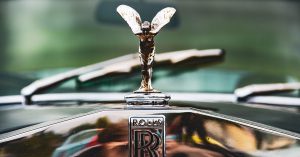
Brand archetype magician, what could be more magical than Rolls Royce?
A Magician dreams big and makes the impossible possible. The Magician is a persevering problem-solver, who can turn something negative into something positive. From fleeting satisfaction to a flow of experiences or even a miracle, the Magician brand archetype helps its clients with transformation.
A true Magician is a pioneer who continues to innovate, providing clients with moments of joy and supporting their transformation. A well-executed Magician builds long-lasting partnerships and a loyal customer base. Fail to deliver as a Magician, or if the promise is too grand? Both clients and competitors will quickly call it out. Keep the promise and execution well-balanced!
In our full article on the Magician brand archetype, we offer two detailed examples, one from an industrial company and one from a business service provider. We also explore the various levels the Magician embodies, benefits, drawbacks, and marketing through a Magician’s lens.
Brand Archetype Innocent

Toyota is the Innocent among car brands
The Innocent is an optimist, in search of the perfect world, believing in simplicity. The Innocent offers simple solutions and choices for a better life or a better world. Simplicity, happiness, and honesty are the core values of Innocent brands.Customers choose the Innocent based on shared values, often at the expense of the dominant market brand. As long as the Innocent meets these collective values, it provides a foundation for a highly loyal customer base. The positive outlook is a major component of the Innocent brand archetype, yet it can also be a pitfall: don’t lose sight of reality.
We delve into the characteristics and marketing approach of the Innocent brand archetype through two examples in our full article on the Innocent brand archetype.
Brand Archetype Creator

Tesla is unmistakably the Creator brand archetype
For the Creator, everything revolves around vision. Creative, technical, and practical, the Creator knows exactly what they want. They pursue an ideal and craft the product or service that brings their vision to life. The Creator is independent, innovative, and always seeking the best solution. They transform the world.
Precisely because the Creator makes the impossible possible, customers are willing to pay a premium for Creator products or services. However, as a Creator, be wary of perfectionism, as it can paralyze the execution of your vision.
In addition to obvious examples like Tesla and Apple, we share two other examples in our full article on the Creator brand archetype, including a business service provider and an industrial example. We also explore the characteristics, benefits, drawbacks, and how to embody the Creator.
Brand Archetype Jester
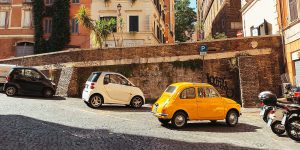
Brand Archetype Jester: the Fiat 500 and Smart exemplify this
Playful and cheerful, yet with a serious vision, the Jester makes problems discussable. Fun and humor for clients take center stage, but the Jester is also critical and brutally honest. In a light-hearted manner, he strives to convey a serious message.
Can you, as a Jester, strike the right tone? If so, both your target audience and other stakeholders will be willing to listen and even take action. The Jester is never shy of publicity and brand ambassadors but must always safeguard the core of his message. If you’re not taken seriously as a Jester, the essence of your message won’t resonate with your audience.
In addition to well-known examples like Smart and Ben & Jerry’s, our full article on the Jester brand archetype provides two more examples: a business service provider from Dutch soil and a renowned international industrial brand. We also delve into the values, characteristics, and marketing of a Jester.
Brand Archetype Ruler

The Ruler of car brands, Mercedes-Benz says ‘The Best or Nothing’
The ruler of the market, always seeking more control and power. The Ruler exudes authority and maintains a certain distance from competitors, suppliers, and customers. With his power and control, he creates order and offers customers safety and success. Customers of the Ruler also seek power, status, and prestige.
As a Ruler, you set the market standard, something that attracts many customers. Customers trust the Ruler and feel at ease, for which they are willing to pay a higher price, allowing the Ruler to capture a significant market share. However, a ruler out of balance quickly turns into a tyrant who doesn’t allow new players, products, or innovations, thereby losing the trust of his followers.Mercedes-Benz is a quintessential Ruler. In our comprehensive article on the Ruler brand archetype, you’ll discover two more intriguing examples of Ruler brands: a business service provider and a major industrial player. Additionally, we delve into the traits and behaviors of typical Ruler brands.
Brand Archetype Lover

The Lover has an extensive potential audience. Unique to this brand archetype is that almost everyone, at some point in their life, resonates with the Lover’s driving force: love. With a well-executed Lover positioning, you build a loyal customer base willing to pay a premium for your brand. Not only do customers feel connected to a Lover brand, but employees also resonate with its culture, which is based more on close collaboration than competition. Affirmation from the audience, both customers and employees, is crucial for the Lover. If this affirmation is lacking, the Lover risks becoming aimless in search of what truly works for its audience, thereby losing sight of its own knowledge and experience. As a natural counterbalance to the pursuit of valuable relationships, jealousy and conflict are potential pitfalls for this brand archetype.Curious about how to approach your marketing as a Lover? In our comprehensive article on the Lover brand archetype, we delve deeper into this and provide real-world examples like Magnum and PPG. Additionally, we clearly outline the three levels of the Lover brand archetype, its advantages and disadvantages, and its characteristics.
Brand Archetype Ally

Volkswagen is the Ally among car brands
The brand archetype Ally always prioritizes its customers’ success over its own fame and glory and excels during uncertain times. The Ally is a steadfast rock amidst the waves and has no trouble finding the right personnel.
The Ally brand archetype suits brands that stand up for an ideal or serve a greater good. The brand acts as an advocate, connector, or servant, always doing what is necessary. And the right ally is, of course, invaluable. The main challenge for the Ally is to find the right balance between customer interests and self-interest.
A selfless ally can calmly build the trust that forms the foundation of a long-term partnership. By being clear about goals and ideals, the brand gains an edge in the job market. Additionally, the Ally can often occupy a unique position in the market. While competitors clearly place themselves at the extremes of the market in terms of price or quality, the Ally can assume a unique ‘best of both worlds’ positioning.